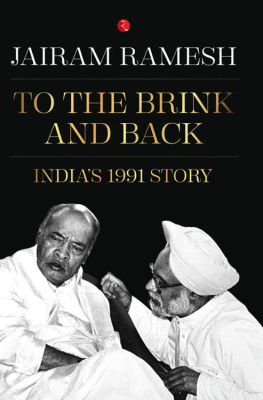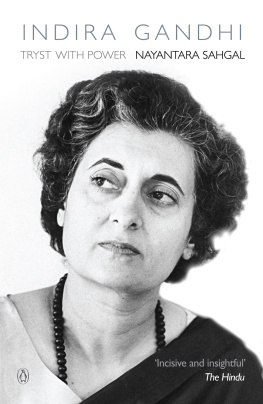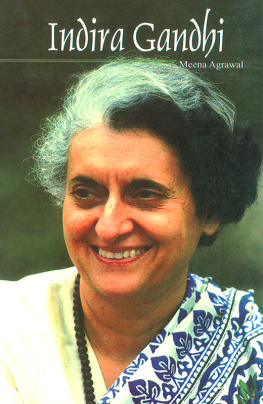Jairam Ramesh - Indira Gandhi: A Life in Nature
Here you can read online Jairam Ramesh - Indira Gandhi: A Life in Nature full text of the book (entire story) in english for free. Download pdf and epub, get meaning, cover and reviews about this ebook. year: 2017, publisher: Simon and Schuster, genre: Non-fiction. Description of the work, (preface) as well as reviews are available. Best literature library LitArk.com created for fans of good reading and offers a wide selection of genres:
Romance novel
Science fiction
Adventure
Detective
Science
History
Home and family
Prose
Art
Politics
Computer
Non-fiction
Religion
Business
Children
Humor
Choose a favorite category and find really read worthwhile books. Enjoy immersion in the world of imagination, feel the emotions of the characters or learn something new for yourself, make an fascinating discovery.
- Book:Indira Gandhi: A Life in Nature
- Author:
- Publisher:Simon and Schuster
- Genre:
- Year:2017
- Rating:3 / 5
- Favourites:Add to favourites
- Your mark:
- 60
- 1
- 2
- 3
- 4
- 5
Indira Gandhi: A Life in Nature: summary, description and annotation
We offer to read an annotation, description, summary or preface (depends on what the author of the book "Indira Gandhi: A Life in Nature" wrote himself). If you haven't found the necessary information about the book — write in the comments, we will try to find it.
Indira Gandhi: A Life in Nature — read online for free the complete book (whole text) full work
Below is the text of the book, divided by pages. System saving the place of the last page read, allows you to conveniently read the book "Indira Gandhi: A Life in Nature" online for free, without having to search again every time where you left off. Put a bookmark, and you can go to the page where you finished reading at any time.
Font size:
Interval:
Bookmark:

INDIRA GANDHI: A LIFE IN NATURE
INDIRA GANDHI
A Life in Nature
Jairam Ramesh

All the birds have flown up and gone;
A lonely cloud floats leisurely by.
We never tire of looking at each other
Only the mountain and I.
Li Po, Alone Looking at the Mountain
For oft, when on my couch I lie
In vacant or in pensive mood,
They flash upon that inward eye
Which is the bliss of solitude;
And then my heart with pleasure fills,
And dances with the daffodils.
William Wordsworth, I Wandered Lonely on a Cloud
It was the Rainbow gave thee birth,
And left thee all her lovely hues; []
Thou hast no proud, ambitious mind;
I also love a quiet place
Thats green, away from all mankind;
A lonely pool, and let a tree
Sigh with her bosom over me.
William Henry Davies, The Kingfisher
These were some of Indira Gandhis favourite poems.
A Note on Names
I HAVE MAINTAINED THE NAMES AS THEY EXISTED DURING INDIRA GANDHIS time although they were changed subsequently.
| Old Name | New Name |
| Simla | Shimla |
| Poona | Pune |
| Bombay | Mumbai |
| Calcutta | Kolkata |
| Orissa | Odisha |
| Bangalore | Bengaluru |
| Baroda | Vadodara |
| Trivandrum | Thiruvananthapuram |
| New Delhi Municipal Committee (NDMC) | New Delhi Municipal Council (NDMC) |
| Madras | Chennai |
| Trichur | Thrissur |
| Dum Dum Airport | Netaji Subhas Chandra Bose International Airport |
| Ceylon | Sri Lanka |
| Giridhar Gomango | Giridhar Gamang |
| Rs (Rupees) |  |
I. A First Word

IT WAS THE NIGHT OF 26 OCTOBER 1984. FIVE DAYS LATER SHE WAS TO be brutally gunned down by her own security guards.
But that was later. For now, she wanted to fulfill a lifes ambitionand said so.
For almost half a century, she had been going to the land of her ancestorsa land she loved as natures paradise. It came with mountains, flowers, gardens, streams and, most of all, treesparticularly chinars that over autumn explode into a spray of coloursfrom a deep vermilion to tones of burnt sienna to pale amber.
She had never seen this gorgeous sight and, after years of putting it off, she desperately wanted to experience it first-hand. The governor of the state advised her against visiting because of the prevailing political situation. But she ignored what he had to say.
Off she went early the next morning, accompanied by her grandchildren, to see the chinar trees in all their glory. She also visited her favourite Dachigam National Parkliterally walking on a carpet of leaves. A strange sense of satisfaction engulfed her.
She came back to Delhi on 28 October and wrote a foreword for a book authored by a ministerial colleague. It happened to be a book on her abiding lovethe environment. She then left for Orissa the next morning. On the 30th, she made her very last speech in Bhubaneswar in which, famously, she seemed to have a premonition of a violent ending to her life soon.
Her premonition turned out to be right. The very next morning at around 9 a.m. she was walking briskly from her home to her adjoining office to record an interview for the BBC. Within a few minutes, however, she was assassinated in a most ghastly manner, at point-blank range, by two men assigned to protect her.
Her funeral was on 3 November. It drew mourners from across the globe. High-powered delegations from numerous countries came as a mark of respect to her. The American team had a world-famous ornithologist who had been in touch with her for over three decades.
As the funeral procession moved to its destination, the naval band played Flowers of the Forest, both of which were very much part of her life. Eight days after her body was consigned to the flames, in keeping with her last wish, Indira Gandhis ashes were sprinkled over the Himalayas with which she had had a special bond, first over Gomukh and Gangotri, and later over Nun Kun and the sacred cave of Amarnath.
Thus passed into history Indira Gandhi, daughter of Jawaharlal Nehru, the prime architect of the modern Indian nation-state.
Thus passed into history Indira Gandhi who herself had been prime minister across two terms for sixteen years and who continues to inspire awe and admiration, draw hostility and criticism.

This is an unconventional biography of Indira Gandhifor it deals with only one aspect of her personality and her record in office.
Why focus on Indira Gandhis life as a naturalist when she was quintessentially a politician?
The answer is simple.
A naturalist is who Indira Gandhi really was, who she thought she was. She got sucked into the whirlpool of politics but the real Indira Gandhi was the person who loved the mountains, cared deeply for wildlife, was passionate about birds, stones, trees and forests, and was worried deeply about the environmental consequences of urbanization and industrialization.
She was the only head of government, other than the host prime minister, to speak at the first-ever United Nations (UN) Conference on the Human Environment in Stockholm in June 1972. Her speech there has reverberated down the decades.
She was singularly responsible not just for Indias best-known wildlife conservation programmenamely, Project Tigerbut also for less high-profile initiatives for the protection of crocodiles, lions, hanguls, cranes, bustards, flamingos, deer and other endangered species.
She almost single-handedly pushed through two lawsone for the protection of wildlife and another for the conservation of forests, which continue to hold sway. Todays laws for dealing with water and air pollution were enacted during her tenure.
Indira Gandhi used her political authority to save ecologically sensitive areas from destruction like the Andaman and Nicobar Islands, the entire northeast and the rainforests in the Western Ghats.
She repeatedly drew the attention of chief ministers and other political colleagues to issues concerning wildlife, forests, pollution, resettlement, and for the need to always maintain what she called ecological balance.
She highlighted, time and again, the inextricable link between Indias natural and built heritage. Indeed, she was one of the very fewperhaps, the only oneto see nature and culture as two sides of the same coin.
It is because of these accomplishments, among several others, that Indira Gandhi deserves to be looked at with a fresh green lens. While her politics and economics changed over the years, all through she remained steadfast to conservation. This passion survived the vicissitudes in her life.
Indira Gandhi had a large network of friends in the conservation community across the world. She kept in touch with them. They had easy access to her. They would write to her directly and she would find time to respond.
Next pageFont size:
Interval:
Bookmark:
Similar books «Indira Gandhi: A Life in Nature»
Look at similar books to Indira Gandhi: A Life in Nature. We have selected literature similar in name and meaning in the hope of providing readers with more options to find new, interesting, not yet read works.
Discussion, reviews of the book Indira Gandhi: A Life in Nature and just readers' own opinions. Leave your comments, write what you think about the work, its meaning or the main characters. Specify what exactly you liked and what you didn't like, and why you think so.










